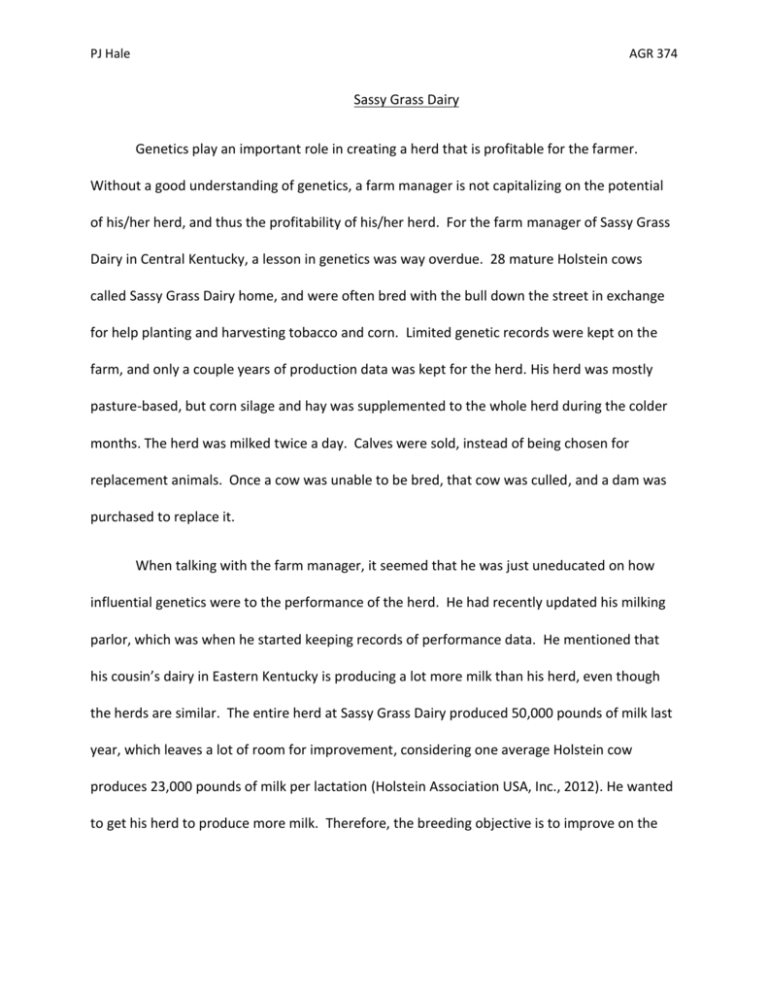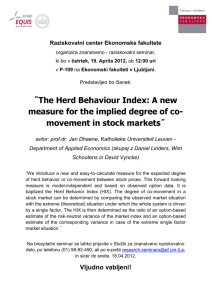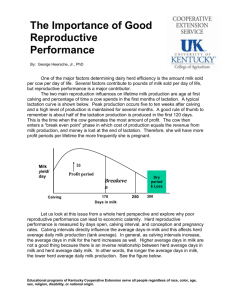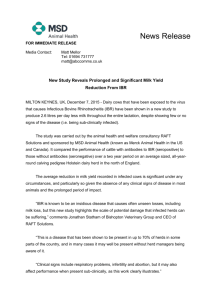File - Pamela J Hale
advertisement

PJ Hale AGR 374 Sassy Grass Dairy Genetics play an important role in creating a herd that is profitable for the farmer. Without a good understanding of genetics, a farm manager is not capitalizing on the potential of his/her herd, and thus the profitability of his/her herd. For the farm manager of Sassy Grass Dairy in Central Kentucky, a lesson in genetics was way overdue. 28 mature Holstein cows called Sassy Grass Dairy home, and were often bred with the bull down the street in exchange for help planting and harvesting tobacco and corn. Limited genetic records were kept on the farm, and only a couple years of production data was kept for the herd. His herd was mostly pasture-based, but corn silage and hay was supplemented to the whole herd during the colder months. The herd was milked twice a day. Calves were sold, instead of being chosen for replacement animals. Once a cow was unable to be bred, that cow was culled, and a dam was purchased to replace it. When talking with the farm manager, it seemed that he was just uneducated on how influential genetics were to the performance of the herd. He had recently updated his milking parlor, which was when he started keeping records of performance data. He mentioned that his cousin’s dairy in Eastern Kentucky is producing a lot more milk than his herd, even though the herds are similar. The entire herd at Sassy Grass Dairy produced 50,000 pounds of milk last year, which leaves a lot of room for improvement, considering one average Holstein cow produces 23,000 pounds of milk per lactation (Holstein Association USA, Inc., 2012). He wanted to get his herd to produce more milk. Therefore, the breeding objective is to improve on the PJ Hale AGR 374 qualities necessary for high producing milk herds, such as milk yield, calving interval, and somatic cell count. With dairy cattle, the amount of milk produced by the herd is usually the first thing on a farm manager’s mind. In order to improve the milk yield of a herd, genetics must be evaluated and a breeding program must be created, which is my task. In addition to milk yield, the breeding program can also improve on the calving interval of the herd as well as somatic cell count. If calving interval can be improved, the herd would have more total days in milk, which means more milk coming from the herd. Calving and milk production often go hand in hand, because lactation occurs after a cow gives birth. Also, if the somatic cell score is improved, the risk of mastitis goes down. If a cow is affected by mastitis, that cow’s milk cannot be sold. Additionally, a “one point increase in somatic cell score is associated with a 400 pound decrease in yield” (Shook, 2008). Improving these traits can improve the overall milk production of the herd. Capitializing on the potential of a herd involves two components: genetic improvement and environmental improvement. A short term goal for this farm is to improve the environment surrounding these cows, including their diet and health. A long term goal for this farm is to improve the genetics of the herd by choosing genetically superior bulls for breeding and choosing those daughters as replacement animals. By improving both of these components, the herd can very easily improve the milk production and make more money for the owner. The major component of improving the herd’s genetics is to use gain knowledge of the current genetics of the herd. In order to improve upon something, you must first know what PJ Hale AGR 374 you are dealing with. The farm manager could genomically test his herd, but that is very expensive. So, using bulls with known genetics would provide a good starting point. For this breeding program, I would suggest using bulls that will produce daughters that have the ability to produce lots of milk, short calving intervals, and low somatic cell counts. I would recommend a bull like 29HO14684 Gallon, whose daughters produce 1,383 pounds, on average, more than their contemporary groups and have an average somatic cell score of 2.86, which is low (ABS Global). Another alternative is to have the local bull genomically tested. He could have very good genetics, but the offspring were all being sold before their potential was known. When you choose genetically superior bulls, you get offspring that have superior genetics. By using the offspring with superior genetics as replacement animals instead of buying new dams, the genetic potential of the herd is better known and money can be saved. Cows would be culled if they are unable to be bred again. I would suggest using artificial insemination (AI) with semen from 29HO14684 Gallon, especially if the local bull cannot be genomically tested or if he has poor genetics. When a trait is easily transferrable from parent to offspring, it is considered to be highly heritable. When a trait is not as easily transferrable from parent to offspring, it is considered to be lowly heritable. Heritability is measured on a scale of 0 to 1. Highly heritable traits fall above or around 0.4. Lowly heritable traits fall below or around 0.2. Traits that fall between 0.4 and 0.2 are considered to be moderately heritable traits. Milk yield is moderately heritable, falling at 0.25 on the scale. Calving interval is lowly heritable sitting at 0.10 on the scale (Bourdon, 2000). Somatic cell score is also lowly heritable, residing at 0.12 on the heritability spectrum PJ Hale AGR 374 (Shook, 2008). Therefore, calving interval and somatic cell scare are affected more by the environment, but genetics do still play a role in the performance. Milk yield is affected more by genetics, but the environment is still important and should not be neglected. In order to improve the environmental conditions that affect the herd, the farm manager must improve the diet and health of the herd. Good nutrition plays a vital role in milk production. I do not think it is necessary to change the nutrition program, as long as the pasture is well- maintained and of good quality. Using other species, such as sheep and goats, in a targeted grazing program can control the presence of certain types of parasites that may be present in the pasture and maintain the quality of the pasture. Keeping the pasture short by chopping it is an alternative to targeted grazing. It is also crucial to test the quality of the corn silage and hay used during times when pasture quality could be compromised, such as in droughts or cold seasons. These tests are usually not too expensive to run and the information that they provide can be very beneficial to the farmer when trying to improve milk production. If the pasture quality is low or inconsistent, then it may be necessary to slowly transition to a total mixed ration, which can be controlled and maintained. The health of the herd is also very important to milk production. The breeding program is targeting the somatic cell score, but there are other aspects of health that can affect milk production. If a cow becomes sick with a virus or a bacterial infection and needs to be put on antibiotics, the antibiotics or virus/bacteria can show up in the milk. Consumers do not like antibiotics or pathogens in their milk, so this milk should not be sold. The health of the cow can also affect the breeding interval. All of the cow’s energy requirements for maintenance, PJ Hale AGR 374 growth, and lactation must be met before reproduction can occur. The best way to improve the health of the herd is to have a large animal veterinarian visit the farm on a regular basis. Maintaining records of pedigrees, performance data, instances of illness, and vaccinations are important in knowing the herd you are trying to improve and can be used when the veterinarian comes to visit. In conclusion, to improve the milk production of the herd at Sassy Grass Dairy, I recommend choosing bulls with superior genetics, focusing on milk yield, breeding intervals, and somatic cell score, choosing superior genetic daughters as replacement animals, testing the quality of the pastures, corn silage, and hay, and maintaining detailed genetic and health records of the herd. By improving the nutrition and health of the herd, the milk production levels can quickly be increased. However, the genetics of the herd must be improved in order for the increase in milk production level to be maintained. Works Cited ABS Global. (n.d.). Gallon. Deforest, WI, USA. Retrieved 4 22, 2015, from http://absbs.absglobal.com/dairy/milk.asp?CodTouro=29HO14684 Bourdon, R. M. (2000). Understanding Animal Breeding. In R. M. Bourdon, Understanding Animal Breeding (Second ed., p. 164). Upper Saddle River, NJ, USA: Prentice-Hall Inc. Holstein Association USA, Inc. (2012). Facts about Holstein Cattle. Retrieved from U.S. Registered Holsteins: http://www.holsteinusa.com/pdf/fact_sheet_cattle.pdf Shook, G. (2008). The Gestation and Birth of Somatic Cell Score. Udder Topics, 31(4). Retrieved 4 23, 2015, from http://nmconline.org/articles/SCSReview.htm







